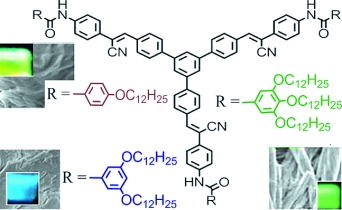
Fluorescent organic molecules with C3-symmetry consisting of tris{2-cyano-2-[4-(dodecyloxybenzoylamino)phenyl]-1-ethenyl}phenylbenzene (CN-DBAPPBn, n = 1, 2, 3) were synthesized. It was observed that these compounds can spontaneously self-assemble into organogels in many organic solvents. Scanning electron microscopy (SEM), light microscopy, and fluorescence microscopy images of the air-dried gels showed the presence of either heavily entangled amorphous or fibrous structures, or rods. FTIR, UV/Vis absorption, excitation and emission spectra suggest that π–π interactions and H-bonding are the driving forces for the formation of the gel phases. Moreover, spherical or cubic fluorescent nanoparticles based on CN-DBAPPBn were prepared by using a reprecipitation method in a mixture of tetrahydrofuran and water. It is interesting that aggregation-induced emission behavior of CN-DBAPPBn was detected in both the gel phase and in the nanoparticle suspensions. The fluorescent molecular aggregates of CN-DBAPPBn with different architectures and emission properties fabricated by using these self-assembling methods could find potential applications in sensors and optoelectronic devices. Eur. J. Org. Chem., 2014, 2907–2916. |

